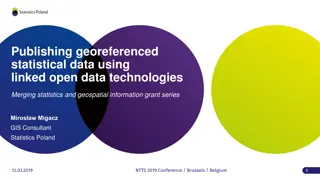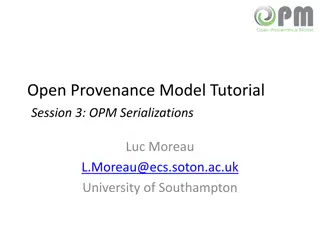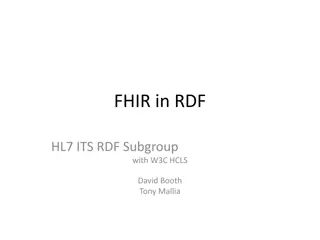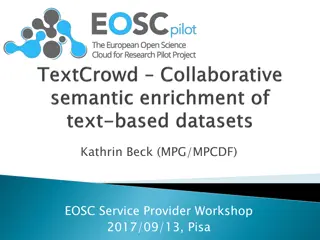Evolution of Freebase and the Google Knowledge Graph
Freebase was initially created in 2005 as an open shared database of knowledge, later acquired by Google and absorbed into the Google Knowledge Graph. Its approach included crowdsourcing updates and additions, focusing on data rather than text. The schema of Freebase included around 1500 types, 3500
1 views • 12 slides
Exporting Relational Data to RDF: Strategies and Considerations
Explore the process of mapping relational data to RDF, including the choice of RDF vocabulary, defining mapping techniques, and exporting strategies. Learn about RDB systems that support RDF, direct mapping approaches, and the use of hybrid storage solutions. Discover how to bridge SPARQL and SQL fo
1 views • 13 slides
Evolution and Demise of Freebase and the Google Knowledge Graph
Freebase was launched in 2005 as an open database of knowledge, initially populated with Wikipedia data and later incorporating crowdsourced updates. Acquired by Google in 2010, it was transitioned into Google's Knowledge Graph before being decommissioned in 2016. The schema contained around 1500 ty
4 views • 12 slides
Understanding RDFa Lite: A Simplified Approach to Structured Data Markup
RDFa 1.1 Lite is a subset of RDFa 1.1 that simplifies structured data markup by employing attributes like vocab, typeof, property, resource, and prefix. It works seamlessly with schema.org terms, enabling easy integration of structured data into web content. The comparison of RDFa Lite with Microdat
2 views • 7 slides
Fascinating World of Radio Direction Finding (RDF) Through History
Explore the intriguing world of Radio Direction Finding (RDF), an essential technique for determining the direction of radio signals. From its origins with Heinrich Hertz in 1888 to its pivotal role in military operations during WWI and WWII, RDF technology has evolved over the years while still rel
9 views • 23 slides
Overview of Semantic Web and RDF Concepts
This content delves into concepts related to Semantic Web, RDF (Resource Description Framework), and formalisms of Trust Reasoning Representation. It covers topics such as RDF resource description, triple models, machine interpretation challenges, and the role of key figures like Timothy John Berner
0 views • 38 slides
Development of Guidelines for Publishing Georeferenced Statistical Data Using Linked Open Data Technologies
Development of guidelines for publishing statistical data as linked open data, merging statistics and geospatial information, with a primary focus on preparing a background for LOD implementation in official statistics. The project aims to identify data sources, harmonize statistical units, transfor
2 views • 31 slides
Semantic Web Technologies and Knowledge Representation Overview
Semantic Web technologies such as RDF, RDFS, OWL, and SPARQL form the basis of a web of data designed for machine understanding. Knowledge representation languages play a crucial role in AI, with Semantic Web languages like OWL leading the current generation. Contrasting database and knowledge base
0 views • 50 slides
Overview of Open Provenance Model Tutorial Session 3
Explore Session 3 of the Open Provenance Model Tutorial, covering topics like the XML Schema for OPM, OWL ontology, OPM Layered Architecture, XML Binding, RDF Binding, and more. Dive into OPM Layered Model, XML Binding, OPM Graph, OPM Process, and OPM Artifact to understand specialized domains and e
0 views • 22 slides
FHIR in RDF: Requirements for Ontology Mapping and Semantic Representation
Define lossless bi-directional transformations, complete FHIR coverage, enforce constraints, enable inference, and ensure RDF quality in representing FHIR resource instances. Support vocabulary bindings, annotation information, and datatype IRIs while ensuring auto-generatability of mappings.
0 views • 5 slides
Analysis of ERCOT Issues and Solutions by Luminant Energy
The analysis delves into ERCOT's identified issues and solutions regarding energy scarcity, examining historical data to pinpoint causes behind potential shortages. By reviewing specific time periods and the impact of various factors like Resource Deployment Factors (RDF) and Reserve Response Servic
0 views • 9 slides
BabyDayOut Ontology: Describing Picture with Classes, Instances, and Relations
Ontology "BabyDayOut" is developed using RDF/RDFS to describe a picture. It includes classes such as Person, Animal, Baby, Picture, Man, and Gorilla with instances like John, KingKong, Jack, Peter, and Alex. Various relations like hasFriend, hasAnimalFriend, sonOf, depicts, hasEnemy, and hasTitle ar
0 views • 9 slides
Understanding Metadata and RDF in Data Management
Explore the significance of metadata in data management, the use of RDF and triple stores in organizing data, different reasoning methods available, and the importance of metadata structures. Learn how schemas in RDF allow for easy integration of diverse data types without requiring database reorgan
0 views • 18 slides
Workshop on EOSC Service Provider Challenges and Solutions in Pisa
Workshop held in Pisa addressing challenges and solutions for EOSC service providers in the realm of Social Sciences, Humanities, and Cultural Heritage. Discussions revolved around fragmented research landscapes, text-based datasets, linguistic annotations, and machine learning models for NLP tools.
0 views • 17 slides
Understanding Intelligent Agents and Semantic Networks in Computing
Explore the world of intelligent agents, XML, RDF, OWL, ontologies, and class constructors in computing. Delve into how these technologies enable machines to understand, communicate, and process data efficiently.
0 views • 23 slides
Understanding Linked Data: Basics to Publishing and Beyond
Delve into the world of Linked Data with topics ranging from its fundamental principles like URIs, RDF, and Triples to practical aspects like publishing data using standard web technologies such as HTTP. Explore the essence of RDF graphs, the significance of naming things with URLs, and ways to prov
0 views • 26 slides
Metadata Cleansing Using SPARQL Update Queries
Learn how to transform and cleanse RDF metadata using SPARQL Update queries to conform to the ADMS-AP for Joinup. This tutorial provides essential knowledge on converting metadata for interoperability solutions and the main queries involved. Discover how to ensure your metadata is compliant and read
0 views • 37 slides
Understanding Resource Description Framework (RDF) for Semantic Web
Resource Description Framework (RDF) is a key data model for the Semantic Web, providing a standard way to represent knowledge through subject-predicate-object triples. RDF serves as the foundation for various knowledge representation languages and ontology tools on the web. Through RDF, relationshi
0 views • 36 slides
Mechanized Model for CAN Protocols - FASE 2013
This research paper presents a mechanized model for Content Addressable Network (CAN) protocols, focusing on supporting RDF data storage in the Semantic Web. It discusses the general motivation, CAN principles, RDF queries, and challenges in handling queries over variables in large-scale settings. T
0 views • 26 slides
RDA and Linked Data: Exploring Beyond the Rules
Explore the intersection of RDA and Linked Data through insightful discussions on leveraging URIs, RDF graph models, and the potential for machine interoperation of library data. Delve into the concept of encoding data in a graph format and the vast possibilities it opens up in the information commu
0 views • 16 slides
Understanding Jena SPARQL for Mac and RDF Queries
Jena SPARQL for Mac is a powerful tool for querying RDF graphs using SPARQL. Learn about RDF graphs, models, triples, and how SPARQL queries work. Explore ARQ, a query engine that supports the SPARQL RDF Query language and features multiple query languages. Discover how to install ARQ and execute SP
0 views • 25 slides
Digital Transformation and Dynamic Risk Management in Rail Safety by Miguel Figueres-Esteban at Renfe
Miguel Figueres-Esteban, a Telecommunications Engineer with a PhD in Psychology, leads the Digital Transformation and Training at Renfe. He is instrumental in developing a Safety Enterprise Architecture and a Safety Knowledge Graph to enhance risk management in railway safety. Renfe, under his leade
0 views • 4 slides
Piloting Unique Identifiers for Geospatial Data - Nordic Forum Presentation
Presentation at the Nordic Forum for Geography and Statistics on piloting unique identifiers for geospatial data by Tuuli Pihlajamaa. The agenda included terms used, background for the pilot, aims, results, and future plans. Detailed discussions on terms like URI, RDF, JHS 193, INSPIRE guidelines, a
0 views • 15 slides
Cutting-Edge Open Source Haystack Libraries and RDF Updates by Gareth Johnson
Explore the latest innovations in open-source Haystack libraries and RDF updates presented by Gareth Johnson, the Chief Software Architect at J2 Innovations, a Siemens Company. Gain insights into advanced technologies such as haystack-core in TypeScript, haystack-nclient for TypeScript clients, and
0 views • 11 slides
Understanding RDF Schema: A Deep Dive into Semantic Web
In this detailed exploration of RDF Schema, Dr. Nicholas Gibbins covers topics such as defining classes and properties, subclass relationships, semantic implications, reflexive properties, type distribution, and property definitions in RDF. Learn about the essential aspects of RDF Schema and its rol
0 views • 19 slides
























